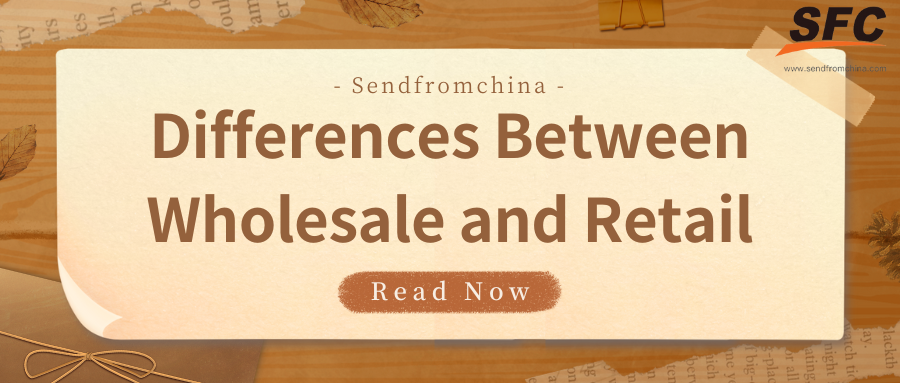Table of Contents
Differences Between Wholesale and Retail: A Comprehensive Guide
Time: Jun 10,2025 Author: SFC Source: www.sendfromchina.com
In the intricate world of commerce, understanding the distinctions between wholesale and retail is paramount for entrepreneurs, business owners, and consumers alike. These two fundamental business models serve as the backbone of the supply chain, each with its unique characteristics, advantages, and challenges.Wholesale and retail operations differ significantly in their approach to sales, customer engagement, pricing strategies, and overall business objectives. Wholesale typically involves selling goods in large quantities to retailers or other businesses, focusing on volume and efficiency. In contrast, retail centers on selling products directly to the end consumer, emphasizing customer experience and personalized service.
Grasping the nuances between these models is crucial for making informed decisions, whether you're considering launching a new venture, optimizing an existing business, or simply aiming to understand the market dynamics better. This comprehensive guide delves into the core concepts, delineates the differences, explores the advantages, examines the supply chain architectures, and provides insights on choosing between wholesale and retail.
By the end of this article, you'll have a clear understanding of how wholesale and retail function, their respective benefits, and how to determine which model aligns best with your business goals and market needs.
1. Definition and Core Concepts: Wholesale and Retail

What Is Wholesale?
Wholesale refers to the practice of purchasing goods in large quantities directly from manufacturers or distributors and reselling them to retailers, other businesses, or institutional clients. This model operates on a business-to-business (B2B) basis, focusing on bulk transactions that offer lower per-unit costs. Wholesalers typically do not sell directly to the end consumer.Key Characteristics of Wholesale:
- Bulk Transactions: Wholesalers buy and sell products in large volumes, benefiting from economies of scale.
- Lower Per-Unit Pricing: Due to bulk purchasing, wholesalers can offer products at reduced prices compared to retail.
- Limited Product Variety: Wholesalers often specialize in specific product categories or industries.
- Minimal Customer Interaction: The focus is on transactions with businesses rather than individual consumers, resulting in less emphasis on customer service.
- Operational Focus: Emphasis is placed on logistics, inventory management, and maintaining relationships with suppliers and retailers.
Wholesalers serve as intermediaries in the supply chain, bridging the gap between manufacturers and retailers. They play a crucial role in distributing products efficiently and cost-effectively.
What Is Retail?
Retail involves selling products directly to the end consumer for personal use. This model operates on a business-to-consumer (B2C) basis, focusing on individual transactions that often involve smaller quantities and higher per-unit prices.Key Characteristics of Retail:
- Direct Consumer Sales: Retailers sell products directly to individuals through various channels, including physical stores and online platforms.
- Higher Per-Unit Pricing: Retail prices are typically higher than wholesale prices to cover operational costs and generate profit.
- Diverse Product Offerings: Retailers often offer a wide range of products to cater to different consumer preferences.
- Customer Experience Focus: Emphasis is placed on customer service, store ambiance, and personalized shopping experiences.
- Marketing and Branding: Retailers invest in advertising and promotional activities to attract and retain customers.
Retailers are the final link in the supply chain, delivering products to consumers and influencing purchasing decisions through various marketing and customer engagement strategies.
Core Concepts in Wholesale and Retail
Understanding the foundational principles of wholesale and retail is essential for businesses operating in these sectors. Key concepts include:- Supply Chain Dynamics: Both wholesalers and retailers are integral components of the supply chain, facilitating the movement of goods from manufacturers to end consumers.
- Market Segmentation: Identifying and targeting specific market segments is crucial for both wholesalers and retailers to meet the needs of their respective customer bases.
- Inventory Management: Efficient inventory control ensures that businesses can meet demand without overstocking or understocking products.
- Pricing Strategies: Determining appropriate pricing involves considering factors such as cost of goods sold, market demand, competition, and desired profit margins.
- Customer Relationships: While wholesalers focus on building relationships with business clients, retailers prioritize direct engagement with consumers to foster loyalty and repeat business.
These core concepts form the foundation upon which wholesale and retail businesses operate, influencing decision-making processes and strategic planning.
2. Differences Between Wholesale and Retail
While wholesale and retail are integral components of the supply chain, they operate on distinct principles, cater to different audiences, and employ varied strategies. Understanding these differences is crucial for businesses to determine the most suitable model for their operations.
Target Audience
- Wholesale: Operates on a Business-to-Business (B2B) model, selling products in bulk to other businesses, such as retailers, resellers, or institutions. The primary focus is on building long-term relationships with clients who purchase large quantities.- Retail: Follows a Business-to-Consumer (B2C) approach, selling products directly to individual consumers for personal use. Retailers prioritize customer experience and satisfaction to encourage repeat purchases.
Transaction Volume and Order Size
- Wholesale: Deals with large-volume transactions, often involving bulk orders. This model benefits from economies of scale, allowing wholesalers to offer lower per-unit prices.- Retail: Handles smaller, individual transactions. Retailers sell products in single units or small quantities, focusing on a higher number of transactions to achieve profitability.
Pricing Structure and Profit Margins
- Wholesale: Offers products at lower per-unit prices due to bulk sales. Profit margins per unit are typically lower, but overall profitability is achieved through high sales volume.- Retail: Sells products at higher per-unit prices, incorporating markups to cover operational costs and generate profit. While the sales volume per transaction is lower, the profit margin per unit is higher.
Customer Interaction and Service
- Wholesale: Customer interactions are centered around negotiations, contracts, and long-term relationships with business clients. The emphasis is on reliability and consistency in supply.- Retail: Focuses on direct engagement with individual consumers. Retailers invest in customer service, personalized experiences, and after-sales support to build brand loyalty.
Marketing and Sales Strategies
- Wholesale: Marketing efforts are directed towards other businesses, utilizing trade shows, industry events, and direct outreach. The goal is to establish partnerships and bulk sales agreements.- Retail: Employs consumer-focused marketing strategies, including advertising, promotions, and social media campaigns. Retailers aim to attract and retain individual customers through brand awareness and engagement.
Inventory Management and Storage
- Wholesale: Requires substantial storage facilities to manage large inventories. Inventory turnover is slower, and efficient logistics are essential to handle bulk shipments.- Retail: Manages smaller inventories with faster turnover rates. Retailers need to balance stock levels to meet consumer demand without overstocking.
Location and Accessibility
- Wholesale: Often situated in industrial areas or near transportation hubs to facilitate large-scale distribution. Physical storefronts are less critical.- Retail: Locations are chosen based on consumer accessibility, such as shopping malls, high streets, or online platforms. Visibility and foot traffic are vital considerations.
Operational Costs
- Wholesale: Operational expenses are primarily associated with warehousing, logistics, and supply chain management. Marketing and customer service costs are relatively lower.- Retail: Incur higher operational costs due to expenses like rent, utilities, staffing, and marketing efforts aimed at attracting consumers.
Product Range and Customization
- Wholesale: Offers a limited range of products in large quantities, focusing on standardized items suitable for mass distribution.- Retail: Provides a diverse product assortment, often including customized or niche items tailored to specific consumer preferences.
Risk and Competition
- Wholesale: Faces risks related to large inventory holdings and dependency on a limited number of clients. Competition is based on pricing, reliability, and supply capabilities.- Retail: Encounters intense competition in attracting consumers, requiring constant innovation, marketing, and customer engagement to maintain market share.
3. Advantages of Wholesale and Retail
Understanding the distinct advantages of wholesale and retail models is crucial for businesses to determine the most suitable approach for their operations.
Advantages of Wholesale
- Economies of Scale: Wholesalers purchase goods in large quantities, allowing them to benefit from lower per-unit costs. This bulk buying power can lead to significant savings and increased profit margins.- Lower Marketing Expenses: Since wholesalers primarily deal with other businesses rather than end consumers, they often spend less on marketing and advertising efforts. This focus on B2B relationships can result in reduced promotional costs.
- Stable Revenue Streams: Wholesalers often establish long-term contracts with retailers, providing a consistent and predictable income. These ongoing relationships can offer financial stability and facilitate better forecasting.
- Expertise and Market Insight: Operating between manufacturers and retailers, wholesalers gain valuable insights into market trends and consumer demands. This position allows them to advise retailers on product selections and inventory management.
- Expanded Market Reach: By partnering with various retailers, wholesalers can distribute products across different regions without the need to establish their own retail outlets, effectively broadening their market presence.
Advantages of Retail
- Direct Customer Engagement: Retailers interact directly with end consumers, allowing them to build strong relationships, gather immediate feedback, and tailor offerings to customer preferences.- Higher Profit Margins: Retailers typically sell products at higher markups compared to wholesalers, leading to greater profit per unit sold. This pricing strategy compensates for lower sales volumes.
- Brand Control and Experience: Retailers have the opportunity to shape the customer experience and control how their brand is perceived through store layout, customer service, and marketing efforts.
- Flexibility in Product Offerings: Retailers can quickly adapt to changing consumer trends by adjusting their product selections, allowing them to stay relevant and meet customer demands effectively.
- Multiple Sales Channels: Retailers can leverage various platforms, including physical stores, e-commerce websites, and social media, to reach a broader audience and increase sales opportunities.
4. Supply Chain Architectures of Wholesale and Retail
The supply chain architectures of wholesale and retail differ significantly in structure, complexity, and technological integration. Understanding these distinctions is crucial for businesses to optimize operations, reduce costs, and enhance customer satisfaction.
Wholesale Supply Chain Architecture
In the wholesale model, the supply chain is primarily linear, focusing on the efficient movement of large quantities of goods from manufacturers to retailers or other businesses. Key components include:- Procurement and Bulk Purchasing: Wholesalers purchase large volumes of products directly from manufacturers or suppliers, often at discounted rates due to bulk buying.
- Storage and Inventory Management: Goods are stored in warehouses, requiring robust inventory management systems to track stock levels, manage shelf life, and plan replenishments.
- Order Fulfillment and Distribution: Orders from retailers or other businesses are processed and shipped in bulk, necessitating efficient logistics and transportation networks.
- Technology Integration: Modern wholesalers are adopting technologies like RFID tagging, automated inventory tracking, and predictive analytics to streamline operations and improve efficiency.
Challenges in wholesale supply chains include managing large inventory volumes, mitigating risks associated with demand fluctuations, and maintaining strong relationships with both suppliers and customers.
Retail Supply Chain Architecture
Retail supply chains are more complex and customer-centric, focusing on delivering products directly to end consumers through various channels. Key components include:- Demand Forecasting and Inventory Planning: Retailers use advanced analytics and AI-driven tools to predict consumer demand, optimize stock levels, and reduce instances of overstocking or stockouts.
- Omnichannel Integration: Modern retailers operate across multiple channels, including physical stores, e-commerce platforms, and mobile apps, requiring integrated systems to provide a seamless customer experience.
- Order Fulfillment and Last-Mile Delivery: Retailers must efficiently manage order processing and delivery, often offering options like in-store pickup, home delivery, and same-day shipping to meet consumer expectations.
- Customer Relationship Management (CRM): Retailers leverage CRM systems to personalize marketing efforts, manage customer interactions, and build brand loyalty.
- Technology Adoption: Retailers are increasingly implementing AI and machine learning technologies to enhance inventory management, personalize customer experiences, and streamline supply chain operations.
The retail supply chain must be agile and responsive to rapidly changing consumer preferences, seasonal trends, and market dynamics.
Comparative Overview
Aspect |
Wholesale Supply Chain | Retail Supply Chain |
|---|---|---|
Primary Focus |
B2B transactions, bulk distribution | B2C transactions, individual sales |
Inventory Volume |
High-volume, bulk storage | Lower volume, diverse product range |
Customer Interaction |
Limited, business clients | Direct, end consumers |
Technology Utilization |
Inventory tracking, logistics optimization | AI-driven demand forecasting, CRM systems |
Distribution Channels |
Direct to businesses, fewer channels | Multiple channels: in-store, online, mobile |
Supply Chain Complexity |
Relatively linear | Highly complex, omnichannel integration |
5. How to Choose Wholesale or Retail
Selecting between wholesale and retail business models is a pivotal decision that hinges on various factors, including your business objectives, resources, market dynamics, and personal preferences. Below is a detailed guide to help you make an informed choice.
Business Goals and Vision
- Wholesale: If your aim is to achieve high-volume sales with lower per-unit profit margins, wholesale might be suitable. This model focuses on building relationships with retailers or other businesses, emphasizing bulk transactions and long-term contracts.- Retail: If you aspire to build a brand, engage directly with consumers, and have control over the customer experience, retail could be the better option. This model allows for higher per-unit profit margins and direct feedback from end-users.
Capital Investment and Operational Costs
- Wholesale: Requires significant upfront capital to purchase inventory in bulk and invest in storage facilities. Operational costs are primarily associated with warehousing, logistics, and maintaining relationships with business clients.- Retail: Generally involves lower initial investment compared to wholesale. However, ongoing operational costs can be higher due to expenses like rent for storefronts, marketing, staffing, and customer service.
Target Market and Customer Interaction
- Wholesale: Focuses on B2B transactions, dealing with retailers, resellers, or other businesses. Customer interaction is limited, and the emphasis is on reliability and efficiency in fulfilling large orders.- Retail: Engages directly with individual consumers (B2C), requiring a strong emphasis on customer service, personalized experiences, and building brand loyalty.
Product Type and Market Demand
- Wholesale: Suitable for products that are standardized, have consistent demand, and can be sold in large quantities. Examples include raw materials, industrial supplies, or generic consumer goods.- Retail: Ideal for products that benefit from branding, customization, or have niche appeal. This includes fashion items, electronics, or specialty foods where consumer preferences play a significant role.
Marketing and Sales Strategy
- Wholesale: Relies on building relationships with a smaller number of clients, often through direct outreach, trade shows, or industry networks. Marketing efforts are more targeted and less extensive.- Retail: Requires broad marketing strategies to attract and retain customers. This includes advertising, promotions, social media engagement, and creating a compelling in-store or online shopping experience.
Scalability and Growth Potential
- Wholesale: Offers scalability through expanding the client base and entering new markets. However, growth is often dependent on the capacity to handle larger volumes and maintain supply chain efficiency.- Retail: Growth can be achieved by opening new locations, expanding product lines, or enhancing online presence. However, it requires careful management of customer relationships and market trends.
Risk Tolerance and Flexibility
- Wholesale: Carries risks related to large inventory holdings, dependency on a limited number of clients, and market fluctuations. Flexibility is limited due to the scale of operations and contractual obligations.- Retail: Faces risks associated with changing consumer preferences, high competition, and the need for continuous innovation. However, it offers greater flexibility to adapt to market trends and customer feedback.
Hybrid Approach
Some businesses opt for a hybrid model, combining elements of both wholesale and retail. This approach allows for diversified revenue streams, broader market reach, and the ability to leverage the strengths of each model.6. Conclusion
Wholesale and retail are integral components of the supply chain, each with distinct characteristics, advantages, and challenges. Understanding their differences is vital for businesses to make informed decisions that align with their goals, resources, and market demands. Whether choosing wholesale, retail, or a combination of both, success depends on strategic planning, market understanding, and efficient operations.7. FAQs
Q1: Can a business operate both wholesale and retail models?
Yes, many businesses adopt a hybrid approach to reach a broader market and diversify income streams.Q2: Which model requires more capital investment?
Wholesale often requires more capital upfront due to bulk purchasing and storage needs.Q3: Is retail more profitable than wholesale?
Retail can offer higher profit margins per unit, but wholesale may achieve profitability through volume sales.Q4: How does customer interaction differ between the two models?
Retail involves direct interaction with consumers, focusing on customer service. Wholesale interactions are primarily business-to-business.Q5: What factors should influence my choice between wholesale and retail?
Consider your target market, capital availability, business goals, and operational capabilities when choosing between the two models. Post Views:917
Post Views:917
Copyright statement: The copyright of this article belongs to the original author. Please indicate the source for reprinting.
Previous Post
Backorders vs Out of Stock: A Comprehensive Guide
Next Post
FCA vs. Other Incoterms: What Makes Free Carrier So Flexible?
TAGS
Hot Research
Recent News
Get a Custom China Fulfillment Solution with FREE Storage for 30 Days
 Want to know about our services, fees or receive a custom quote?
Want to know about our services, fees or receive a custom quote?
 Please fill out the form on the right and we will get back to you within a business day.
Please fill out the form on the right and we will get back to you within a business day.
 The more information you provide, the better our initial response
will be.
The more information you provide, the better our initial response
will be.





 TAGS:
TAGS: